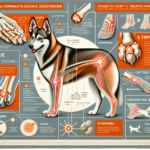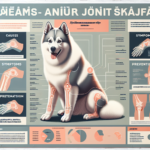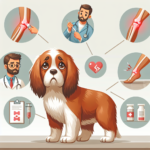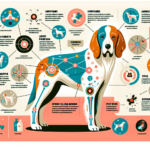Norwegian Lundehund Joint Pain: Causes, Symptoms, Prevention, and Treatment

Introduction
The Norwegian Lundehund is a unique and fascinating breed known for its distinctive characteristics and historical significance. Originating from Norway, this breed was primarily used for hunting puffins on steep cliffs, thanks to its extraordinary agility and flexibility. The Norwegian Lundehund is characterized by its six toes on each foot, double-jointed neck, and the ability to close its ears to protect against dirt and moisture. Despite its remarkable traits, the breed is not without its health concerns, one of which is joint pain.
Joint health is a critical aspect of overall well-being for the Norwegian Lundehund. Given their active nature and unique physical structure, maintaining healthy joints is essential to ensure they lead a comfortable and active life. This article delves into the causes, symptoms, prevention, and treatment of joint pain in Norwegian Lundehunds, providing a comprehensive guide for owners and enthusiasts.
Breed-Specific Joint Pain Risks
Genetic Predisposition
The Norwegian Lundehund, like many purebred dogs, has a genetic predisposition to certain joint-related issues. Hip dysplasia, a condition where the hip joint does not fit properly into the hip socket, is one such concern. This can lead to arthritis and significant pain over time. Elbow dysplasia, another genetic condition, affects the elbow joint and can cause lameness and discomfort. These genetic predispositions make it crucial for breeders to screen for these conditions to reduce their prevalence in future generations.
Age-Related Risks
As Norwegian Lundehunds age, the risk of developing joint pain increases. Arthritis, a common age-related condition, can affect the breed, leading to stiffness, pain, and reduced mobility. Owners should be vigilant as their dogs approach middle age, typically around 6-8 years, and monitor for any signs of joint discomfort. Early intervention can significantly improve the quality of life for aging dogs.
Activity Level and Joint Stress
The Norwegian Lundehund is an active and agile breed, often engaging in activities that can put stress on their joints. Whether they are climbing, running, or playing, the high activity level can contribute to joint wear and tear. While exercise is essential for their overall health, it is important to balance activity with rest and ensure that their joints are not overburdened.
Common Symptoms of Joint Pain in Norwegian Lundehund
General Symptoms
Owners should be aware of common symptoms of joint pain in their Norwegian Lundehund. These include:
- Limping or favoring one leg
- Stiffness, especially after rest
- Reluctance to jump, run, or climb stairs
- Decreased activity or playfulness
- Swelling around the joints
- Whining or showing signs of discomfort when touched
Breed-Specific Symptoms
While the general symptoms of joint pain are similar across breeds, Norwegian Lundehunds may exhibit some breed-specific signs. Due to their unique physical structure, they might show more pronounced limping or stiffness in their extra toes or neck. Owners should pay close attention to any unusual movements or behaviors that could indicate joint pain.
When to Consult a Vet
If any of the above symptoms are observed, it is crucial to consult a veterinarian promptly. Early diagnosis and treatment can prevent the progression of joint pain and improve the dog’s quality of life. Regular veterinary check-ups are also essential for monitoring joint health and catching any issues early.
Preventive Measures for Joint Health
Exercise Recommendations
Maintaining an appropriate exercise routine is vital for the Norwegian Lundehund’s joint health. Low-impact exercises such as swimming and controlled walking are excellent options. These activities help strengthen muscles without putting excessive strain on the joints. Avoid high-impact activities like jumping or running on hard surfaces, which can exacerbate joint issues.
Dietary Suggestions
A balanced diet rich in essential nutrients can support joint health. Foods containing glucosamine, chondroitin, and omega-3 fatty acids are particularly beneficial. These nutrients help maintain cartilage health and reduce inflammation. Owners may also consider joint supplements, but it is advisable to consult a veterinarian before adding any supplements to the dog’s diet.
Weight Management
Maintaining a healthy weight is crucial for reducing joint stress. Excess weight can exacerbate joint pain and lead to further complications. Owners should monitor their Norwegian Lundehund’s weight and ensure they are feeding an appropriate amount of high-quality food. Regular exercise and portion control are key components of effective weight management.
Early Screening and Monitoring
Early screening for joint issues can make a significant difference in managing and preventing joint pain. Regular veterinary check-ups should include joint assessments, especially as the dog ages. Breeders should also conduct genetic screenings to identify potential joint issues in puppies, allowing for early intervention and management.
Treatment Options for Joint Pain
Non-Surgical Treatments
Non-surgical treatments are often the first line of defense against joint pain. These may include:
- Medications: Anti-inflammatory drugs and pain relievers can help manage pain and reduce inflammation.
- Physical Therapy: Specialized exercises and therapies can improve joint function and reduce pain.
- Lifestyle Adjustments: Modifying the dog’s activity level and environment to reduce joint stress.
Surgical Options
In severe cases, surgical intervention may be necessary. Common surgical options include:
- Hip Replacement: Replacing the damaged hip joint with an artificial one.
- Arthroscopy: A minimally invasive procedure to clean out the joint and remove damaged tissue.
- Joint Fusion: Fusing the joint to reduce pain and improve stability.
Surgery should be considered only after thorough consultation with a veterinarian and evaluation of the dog’s overall health and quality of life.
Alternative Therapies
Alternative therapies can complement traditional treatments and provide additional relief. These may include:
- Acupuncture: Using needles to stimulate specific points on the body to relieve pain.
- Hydrotherapy: Water-based exercises that reduce joint stress while improving strength and mobility.
- Massage: Gentle massage techniques to improve circulation and reduce muscle tension around the joints.
Lifestyle and Management Tips
Daily Care Routine
A consistent daily care routine can help manage joint pain in Norwegian Lundehunds. This may include:
- Regular, low-impact exercise
- A balanced diet with joint-supporting nutrients
- Weight monitoring and management
- Joint supplements as recommended by a veterinarian
- Regular veterinary check-ups
Modifying the Home Environment
Making the home environment more comfortable can significantly improve the quality of life for a dog with joint pain. Consider the following modifications:
- Installing ramps to avoid stairs
- Providing orthopedic beds for better joint support
- Using non-slip mats to prevent falls
- Ensuring easy access to food, water, and favorite resting spots
Long-Term Management
Long-term management of joint pain involves a combination of preventive measures, regular monitoring, and appropriate treatments. Owners should stay informed about their dog’s condition and work closely with their veterinarian to adjust care plans as needed. Keeping the dog active, comfortable, and engaged is essential for their overall well-being.
FAQs About Norwegian Lundehund and Joint Pain
What are the early signs of joint pain in Norwegian Lundehunds?
Early signs of joint pain include limping, stiffness, reluctance to move, and decreased activity levels. Owners should monitor their dogs closely for these symptoms and consult a veterinarian if they notice any changes.
Can joint pain in Norwegian Lundehunds be prevented?
While it may not be entirely preventable, joint pain can be managed and minimized through proper exercise, a balanced diet, weight management, and regular veterinary check-ups. Early screening and genetic testing can also help identify potential issues before they become severe.
Are there specific exercises that are better for Norwegian Lundehunds with joint pain?
Low-impact exercises such as swimming and controlled walking are ideal for Norwegian Lundehunds with joint pain. These activities help maintain muscle strength without putting excessive strain on the joints.
What dietary supplements are recommended for joint health in Norwegian Lundehunds?
Supplements containing glucosamine, chondroitin, and omega-3 fatty acids are beneficial for joint health. These nutrients support cartilage health and reduce inflammation. Always consult a veterinarian before adding supplements to your dog’s diet.
When should I consider surgery for my Norwegian Lundehund’s joint pain?
Surgery should be considered when non-surgical treatments are no longer effective, and the dog’s quality of life is significantly impacted. Consult with a veterinarian to evaluate the best surgical options based on the dog’s specific condition and overall health.
Conclusion
Joint pain is a significant concern for Norwegian Lundehunds, given their unique physical structure and active nature. Understanding the causes, symptoms, prevention, and treatment options is essential for ensuring their well-being. By taking proactive measures, such as maintaining a balanced diet, providing appropriate exercise, and seeking regular veterinary care, owners can help their Norwegian Lundehunds lead healthy, active, and comfortable lives. Remember, early intervention and consistent management are key to preventing and alleviating joint pain in this remarkable breed.




